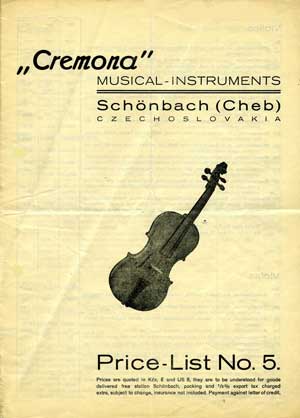

Josef Hӧfner was the first of the two brothers
to return from the war. He arrived back in Schӧnbach at the end of May 1945 to
find his house occupied by four US Army officers, including a Colonel Hilton of
the famous hotel family. Very soon afterwards, the Karl Hӧfner Company was taken
over by the Czechoslovakian state and Josef, Walter’s wife Wanda, and Karl found
themselves working as part of the management of the company that they had
previously owned. The Czech state re-named the company “Cremona”.
In December 1945, a Mr
W. Peterson arrived in Prague, the Czech capital city. Mr Peterson was the owner
of the Wm. Gratz Company of New York, and he had been one of Hӧfner’s best
customers prior to World War Two. After assessing the situation with regard to
his former suppliers, Mr Peterson arranged for Josef Hӧfner together with two
other instrument makers from the former Sudetenland to travel to Prague in
order to discuss the future. At that first meeting, Josef explained the plight
of the Schönbach luthiers and also first learnt about the plans of the Czech
government to expel the majority of the German-speaking population from
Czechoslovakia to what was left of Germany. Certain exceptions to this would be
the Hӧfner family, as they would be expected to carry on managing instrument
manufacture for Cremona.
On his return to the US, Mr Peterson did all
that he could to arrange aid to be sent to the German craftsmen of Schönbach. He
returned to that town in July of the following year, and inspected a large
number of stringed instruments that Cremona had prepared for export. However, he
was not at all happy with the quality of the state-made goods, and made that
opinion very clear to state officials before leaving without placing an order.
Naturally, the officials considered this to be all the fault of the Hӧfner
family, who were accordingly put under considerable pressure, despite the fact
that the resources being allowed by the state to Cremona made the production of
quality instruments impossible.
The Hӧfner family, led by Josef, carried on as
best they could for another two years in Schönbach. They were stateless, being
without papers to show them as German or Czech citizens, but they were still
expected to continue working in the interests of a country that had stripped
them of their family business. Secret discussions even took place between Josef
and Swiss businessmen who wished to explore the possibility of the Höfners
migrating to Switzerland with hand-picked workers from Schönbach and then
setting up an instrument-making company for them in Switzerland. However, the
Czech authorities got wind of these discussions, the Swiss returned home very
quickly, and Josef was interrogated at length. This really was “Cloak and
Dagger” stuff.
Finally, the Czech
authorities realised that special measures would be required in order to
persuade the US distributors such as the Wm. Gratz Company to take their
stringed instruments. An official asked Josef whether he would be prepared to
represent Cremona in America and sell their products there. Josef explained that
this would be impossible as neither he nor his family had any nationality
papers, and therefore would not be allowed into the United States. Within three
weeks, German nationality papers arrived. On 18 April 1948, the Hӧfner family
left Czechoslovakia, not for America, but for Germany. On 19 April, the family
were re-united with Walter Hӧfner in Mӧhrendorf.
An influx of Schönbach
craftsmen, led initially by Arnold Hoyer and later by a certain Fred Wilfer, had
recently occurred into the little town
of Mӧhrendorf
which is just to the north of Erlangen in Bavaria.
Fred Wilfer was not a
luthier. He was a very astute businessman in the same mould as Josef Hӧfner.
He was a man who got things
done. After release from an American prisoner-of-war camp in 1945, he had first
returned to his home in Schönbach from where he managed to be officially
released for medical treatment at the University Clinic in Erlangen. After this
treatment, Fred obtained work with the US army as a purchasing clerk and this
involved him being able to travel freely between Czechoslovakia and Germany. It
was all part of his plan to bring both human and material resources from
Schönbach to Bavaria in order to re-start the musical instrument manufacturing
tradition for which Schönbach was so justly famous.
With help from sympathetic US troops, Wilfer
“liberated” sufficient machines and tone-wood from Schönbach to be able to get
instrument making going again in Mӧhrendorf, all under the noses of the Czech
authorities. This came to an abrupt stop in early 1946, when he was arrested by
the Czechs following the withdrawal of US troops from Czechoslovakia. Luckily, a
US army officer was still in the area at the time, and as Fred was an employee
of the Americans, he insisted on his release.
Fred Wilfer helped
organise immigration permits for further Schönbach craftsmen to move to Bavaria,
and very soon he was in a position to start his new company. Very quickly he had
workshops set up producing orchestral stringed instruments and mandolins in old
barrack buildings in Mӧhrendorf.
Just one problem…….where
could he find a person with the drive and expertise to set up and run the guitar
manufacturing facility?
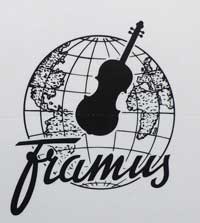
Walter Hӧfner had also been held as a prisoner
by the US forces, but was not finally released until 1947. With the expulsion of
the German speaking population from Czechoslovakia being in full force at that
time, he could not return home to Schönbach. Naturally, Walter headed towards a
re-union with his fellow instrument makers in Mӧhrendorf.
Fred and Walter very
soon pooled their complimentary talents as partners, and the guitar side of
the Framus Company was born. The barrack buildings in Mӧhrendorf had been built
in 1937 for the State Labour Service, and these were now being made available by
the district authorities for both housing and workshops in order to accommodate
the refugee instrument makers.
There was however a problem
in the fact that Walter had not yet been formally cleared of Nazi involvement,
so he could not enter into any business partnership until this had been
properly certified. This problem was initially overcome by Walter’s wife, Wanda,
being nominated as Fred’s partner in Framus. Josef Hӧfner also was co-opted into
the Framus company the following year after he had arrived from Schönbach. He
began the search for export opportunities that would eventually be so important
to the future Framus success story. As one would expect, Walter threw body and
soul into getting things up and running again under the Framus banner at Mӧhrendorf,
and he very soon had a small range of archtop guitars under production.
As well as a good
selection of orchestral stringed instruments, the Framus price list of August
1948 schedules
a total of eight guitars, four of which are “Spanish” and four “Gibson” models.
Framus, in line with several other German manufacturers at that time, described
their archtop guitars as being “Gibson” models; this seemingly being the generic
term for the type of guitar that the US maker had developed and was certainly
the leading manufacturer of. The Framus model numbers however bore no relation
to those used by Gibson. These numbers do look very familiar and were in fact
based upon the old Hӧfner product number system as used for the Primus archtops
made in Schönbach before the war. The following table provides an English
translation of what was in this early Framus price list:
|
No. 455 |
"Gibson Model" Simple Equipment |
DM 108.60 |
|
No. 456 |
Gibson Model. Solid Execution. Brightly Polished |
DM 135 |
|
No. 457 |
Gibson Model. Fine Inlays, Good Execution, Brightly
Polished |
DM 176 |
|
No. 465 |
Gibson Model. Produced from Fine Woods. Fine
Fittings. Artist’s Instrument. |
DM 284 |
We do have some photographs, taken for publicity
purposes, of these four models. They have a strong resemblance to the guitars
made later by the Hӧfner Company in style, body and headstock shape, and even
the fittings used. Walter Hӧfner’s design skills seem to have developed
considerably during his enforced break from the guitar-making world during the
war years. Without a doubt, these are the predecessors to the Hӧfner Company’s
long running and very successful archtop range which we are about to discover in
the following chapters of this book.
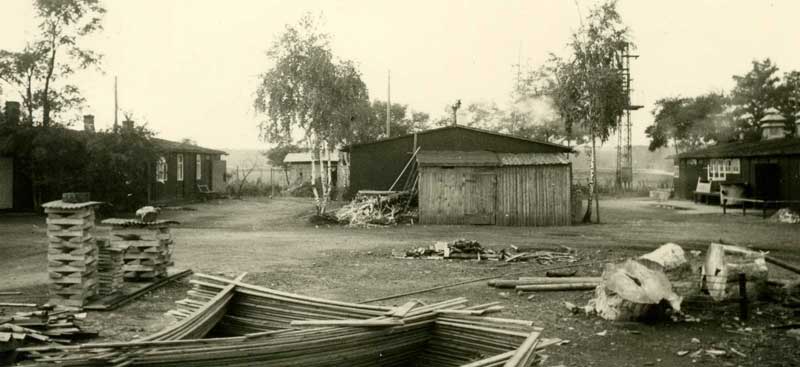
With the two Hӧfner brothers being re-united in
Mӧhrendorf once again, it was inevitable that their thoughts should turn to
re-creating the Hӧfner Company. Before that disastrous war, Hӧfner had been the
largest stringed instrument manufacturer in Europe, and it must have been very
depressing for Walter and Josef to be now working for a company that had not
even existed before 1947. OK, Walter believed that, through his wife, he did
have a substantial stake in Framus, but that was not quite the same as having
his own family name on the business letterhead. Fred Wilfer was very much the
senior partner in Framus, and quite rightly so. The Hӧfner brothers decided to
go their own way and resurrect the Hӧfner Company.
Walter’s departure from Framus was not an
amicable one. Previous agreements had been on a verbal basis only, and so
disputes went on for years after Walter had finally left Framus in October 1948.
However, Walter’s guitar designs continued to be used by Framus for a short
period, and examples featured on Framus’ first trade stand at the 1949 Export
Trade Fair in Hanover. Very quickly after the partnership split however, Framus
changed the direction of their guitar designs, with the more familiar and
distinctive Framus models appearing from 1949 onwards, including the famous
“Black Rose” archtop model launched in 1951.
Framus packed up and left Mӧhrendorf at about
the same time as Walter left them, and Fred Wilfer set up his new workshops in
nearby Baiersdorf. The new Hӧfner Company decided to remain in Mӧhrendorf and to
use the old barracks as temporary workshops until they became fully established
and a more suitable site became available. Hence with Josef and Walter at the
helm, and with many of their loyal employees and home-workers from the Schönbach
days, the Karl Hӧfner Company re-commenced business in January 1949.
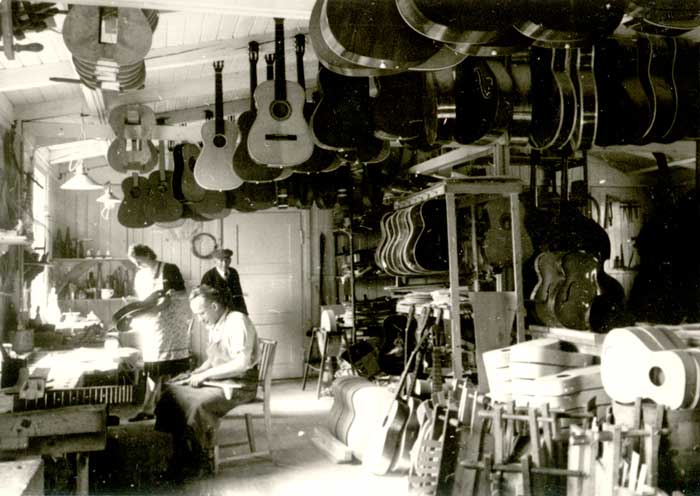
Inside the Mӧhrendorf barracks workshop, c1950.
Within a year, the two brothers had been so
successful in starting up the company that they were able to produce an
eighteen-page catalogue in 1950, which as well as a good selection of orchestral
stringed instruments and classical guitars, also included five archtop guitars
which were referred to as “Schlag-Guitarren” in the catalogue. Hӧfner’s first
pre-war archtops were therefore announced to the World in the following manner:
|
Schlag-Guitarren, (swelled back and top) |
|
|
No. |
|
|
455 |
Maple back and top; F-holes; black-white celluloid
bindings round back and top; celluloid finger-rest. |
|
456 |
Back and top maple construction; F-holes; inlayings
around back, top, fingerboard & F-holes; highly polished. |
|
460 |
Black varnished; highly polished; white celluloid
inlayings around back, top, fingerboard, & F-holes; inlays on neck head. |
|
463 |
Back & sides mahogany; spruce top; fine wood
inlayings around back & top; finger-rest. |
|
465 |
Back & sides rosewood or birds’ eye maple; selected
spruce top - choicest material; pearl inlays on fingerboard and neckhead;
fine master work. |
The 460 was really a deluxe version of the 456
model, with increased purfling around the body edges, neck, and soundholes, plus
heavily inlaid mother of pearl fret-markers and up-rated hardware.
The 463 was a mahogany-bodied
archtop with carved spruce top and heavy ornate purfling around the body edges.
This would appear to have been a new model, although of course Walter Hӧfner had
produced mahogany bodied archtops in the pre-war days at Schonbach. As it
happens, the 463 proved to be one of the backbones of the Hӧfner archtop range through
the years. It was in this first set of models to be produced by the pre-war Hӧfner
Company and it was still being offered in 1994, by which time the old-style
archtops had been superseded by the new Jazzica model. More of that later
though!
c1952 Hӧfner Model 465 (non-original floating pickup fitted.)
The 465 was a very similar guitar in concept to
the Framus 465 model, with rosewood body, but the new Hӧfner guitar was also
offered with the option of a bird’s eye maple back and rim. The 465 was intended
to be very much a “luxury” level guitar, and this was demonstrated by the heavy
purfling around the body edges and neck, the mother of pearl “bell-flower”
design inlaid into the headstock, and the double arrow-head fretmarkers inlaid
in mother of pearl into the initially rosewood (but later ebony) fingerboard.
Hӧfner was now back in the archtop guitar-making
business!
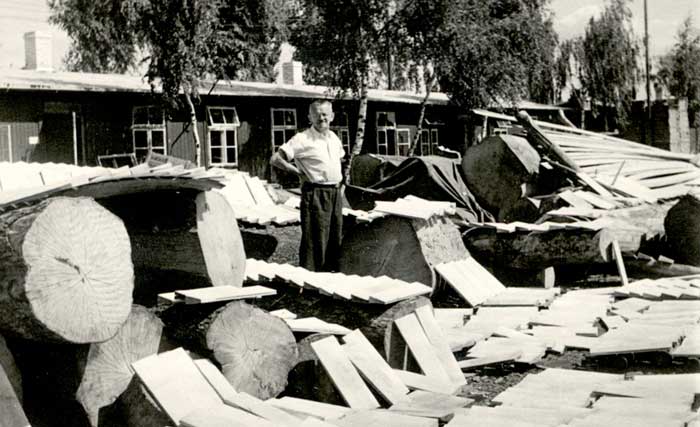
__________________________________________________
All Text is Copyright
© 2022 Steve Russell. All Rights Reserved